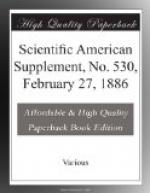[Illustration: FIG. 1.]
Nevertheless, the construction of such apparatus affords a study which to some is fascinating, and even in the abstract is not devoid of utility. In each case a definite object is presented, and usually a choice of methods of attaining it; success requires a thorough knowledge of the properties of the curve in hand, while ingenuity is stimulated, and familiarity with expedients is cultivated, by the effort to select the most available of those properties, and to arrange parts whose motions shall be in accordance with them. Such exercise of the inventive faculties, then, is good training for the mechanician. And it must not be forgotten that a mechanical movement thus devised for one purpose very frequently is either itself applicable to a different one, or proves to be the germ from which are developed new movements which can be made so; the solution of one problem sometimes furnishing a hint or clew of great value in dealing with another.
[Illustration: FIG. 2.]
We proceed, then, to describe a few instruments of this kind, which we believe to be new, in the hope that in the manner just pointed out they may render a greater service than that for which they are directly intended.
The first of these, shown in Fig. 1, is for the purpose of describing the hyperbola. The properties of the curve, upon which the action of the instrument depends, are illustrated in Fig. 2, where MM, NN, are the two branches of an hyperbola; C the center; AB the major axis; F and F’ the foci. If now a tangent TT be drawn at any point as P of either branch, and a perpendicular let fall upon it from the nearer focus F be produced to cut at G a line drawn from P to the farther focus F’, then this perpendicular will cut the tangent at a point I upon the circumference of a circle described about C upon AB as a diameter, and also the distance F’G will be equal to AB.
In Fig. 1, then, we have a crank CI, whose radius is equal to CB, half the major axis, turning about a fixed center C. Upon the crank-pin I is hung, so as to turn freely, a rigid cross composed of a long slotted piece TT, in which slides a block, and two cylindrical arms at right angles to it and in line with each other, the axis EE passing through I. The arm on the right slides through a socket pivoted at the focus F; the one on the left slides through a similar socket, which is pivoted at G to a third socket longer than the others, which again is pivoted at the focus F’; the distance F’G being equal to AB. Through this long socket slides a rod KP, the end P being formed into an eye, by which this rod is pivoted to the block which slides in the long slot, and thus controls the motion of the block; and the pivot at P is centrally drilled to carry the pencil. It is thus apparent that the center line of the slot TT must in all positions be tangent to the hyperbola PBR, which will be traced by the pencil, whose motions are so restricted as always to satisfy the conditions explained in connection with Fig. 2.




